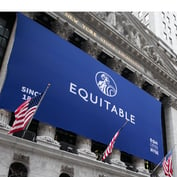With variable annuities undergoing so many changes of late, with fee hikes, benefit cuts and buyback offers flung into the marketplace at a frenetic pace, advisors and their clients are perhaps wondering if it’s time to trade in that old variable annuity for a new one.
That’s just what Jerome Golden, president of Golden Retirement Advisors, pictured, a registered investment advisor, thinks variable annuity (VA) holders should do. His company recently proposed a special 1035 exchange offer for holders of in-force VAs.
should do. His company recently proposed a special 1035 exchange offer for holders of in-force VAs.
Though he admitted in a recent interview that no one has taken him up on his offer just yet he’s still attempting to pinpoint the right marketing avenue Golden, a long-time veteran of the variable annuity business, did give some pertinent insights on the path to the current fitful variable annuity marketplace.
Back in the late ‘80s, when he owned his own life insurance company, Golden American Life, Golden specialized in variable annuities and variable life insurance. According to Golden, his firm was the first to offer a variable annuity with a guaranteed minimum death benefit and multiple managers in the fund lineup. A series of acquisition eventually led to Golden American Life becoming the basis for ING’s U.S. annuity company.
Golden’s next stop was AXA, which had just merged with Equitable. There, he headed up the income management group and helped develop the firm’s Accumulator variable annuity. That circa-1995 product, says Golden, was the first to give owners the option of a guaranteed minimum income benefit (GMIB), or living benefit guarantee.
Yet Golden admits his passion was not so much for products, but rather incorporating investment tools like annuities into a holistic retirement planning system that took clients from the accumulation of assets to transitioning those monies into a stream of retirement income. So in 2009, he started his own New York City-based RIA firm, founded on “the basic notion that most people focus on saving money, accumulating money, but now with boomers retiring, you have to focus how you go from savings to income.”
Thrown a curve
For many who had previously purchased variable annuities, that predestined path to a prosperous retirement has been throw an unsettling curveball as carriers continue to remake contracts to match today’s low-interest rate environment.
As both a first-hand participant and observer of the variable annuity world, Golden says insurers are partly to blame for their current bottom-line squeeze. When the GMIB first came out in the mid-‘90s, it was “incidental” to the basic variable annuity, he says. Back then, an owner held the contract for, say, seven to 15 years; if the policyholder chose to annuitize, then he or she would receive the guaranteed minimum income benefit. “In order to have it be a cost to the company, a policyholder actually had to annuitize their contract,” Golden says
Then, the competitive nature of the marketplace ramped up and insurers began to offer Guaranteed Minimum Withdrawal Benefit (GMWB) riders, which allowed a policyholder to take income without annuitization. Soon, companies began to outdo each other by offering higher and higher withdrawal limits, Golden recalls.
Both the GMIB and GMWB entail some measure of risk, Golden concedes; however, as he sees it, the GMWB is a riskier because of what is known as the sequence of return risk. In that scenario, a policyholder continues to take withdrawals while the market plummets and the insurer goes “deeper and deeper in the hole,” Golden says.
Which is pretty much what happened when the market crashed in 2008, leaving some carriers with a massive amount of unanticipated and onerous liability on their balance sheets.
“It was partly a design issue and partly a hedging issue,” Golden says. “Companies, I don’t care how well they are capitalized, took substantial hits. This has led to these redesigns, weakening of the benefits, limiting the investment choices, increasing the fees and so on.”








 October 23, 2013 at 08:05 AM
October 23, 2013 at 08:05 AM









